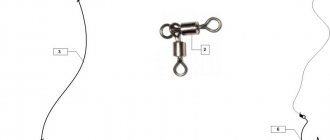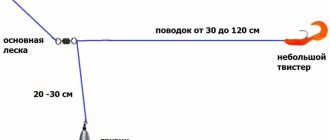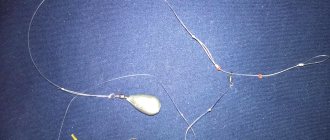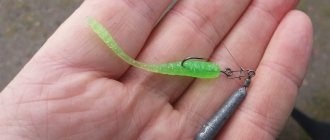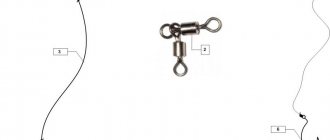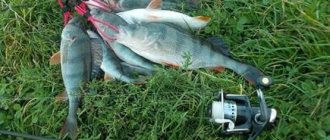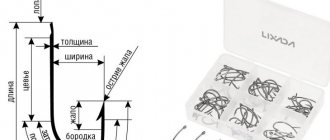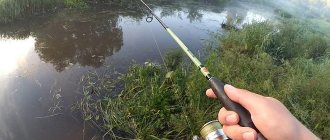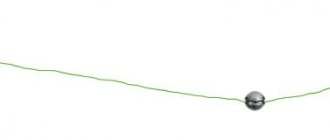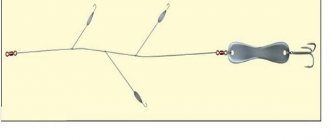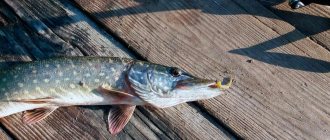Beginning spinning anglers are increasingly interested in the Moscow rig, or, as it has recently come to be called, fishing with a retractable leash.
This method of fishing is gaining popularity day by day, and if this continues, it will soon supplant the classic jig, beloved by many.
Why such interest in this equipment? There is no secret in it, but there are three significant advantages. This is an extraordinary catchability, simple installation and ease of learning. In addition, fishing with a diverting leash does not require any special gear; it is enough to choose the right set of inexpensive but high-quality elements.
Place and time of fishing with a retractable leash
Spinning fishing on a diverting leash using Moscow equipment is possible in any body of water, regardless of the depth and strength of the current. And yet, on small rivers and closed lakes, this amazing method has never found widespread use. It is more suitable for a large or medium-sized river, where it can be used to effectively fish for various bottom irregularities located at a considerable distance from the shore. A retractable leash is primarily for running fishing and long casts, although no one forbade fishing with it from a boat either.
Installation with a diverting leash shows good results throughout the warm season, from early spring until the first serious frost. It is capable of waking up a predator in the heat, when it is extremely passive and is not at all interested in spinners, wobblers and soft baits on a jig head.
Spinning fishing with a retractable leash is aimed at predatory fish that prefer to stay in the bottom horizons. Typically, perch predominates in the catches, but for targeted hunting for pike perch, pike and asp, this method is also quite applicable. Especially if the fish behaves sluggish and apathetic. Moscow equipment should be in the arsenal of every spinning player just for such a case.
Wiring Technique Tips
Fishing with a retractable leash will be successful if you follow the fishing rules and the advice of experienced spinning anglers. Depending on the time of year and the object of hunting, three main methods of wiring are used.
- Posting with swinging of the rod. Evenly winding the fishing line, raise the tip of the form and lower it. This technique is used in the summer and helps catch inactive fish. This wiring is especially good when fishing for perch.
- Uniform wiring. Works great against active predators. This technique can be used in the spring with clearing of the water before fish spawning, and in the fall until frost in October-November.
- Stepped wiring. As with a regular jig: 2-3 turns and pause until it touches the bottom, then repeat. Can be used all year round and on any predator.
Also, fishing with a retractable leash can also vary in the direction of moving the bait from side to side. Perches are especially fond of the darting wobbler; they gather in flocks for zigzag fishing.
Types of postings
There are:
- Jerk wiring. This method of wiring is carried out by sharply pulling the rod. Stops are made periodically, at which we give the bait a play, playing with the tip of the rod in place. Very often it is at stops that the bait is attacked.
- Aggressive wiring. Used on active fish. We make a series of jerks 4 - 6, up to 50 cm long, then there is a short stop with an interval of up to 4 seconds (at this moment the slack is exhausted) and we repeat everything again.
Smooth wiring. In this case, we make smooth pulls with the rod, so that the load actually drags along the bottom without breaking away from it; periodically we make small stops, during which we continue to play with the tip of the rod.
In still water, the effectiveness of this wiring is lower and you should expect that the predator will be interested in the cloud of turbidity raised by the sinker.
A retractable leash for spinning rods, great for fishing in currents. At the same time, you can use various animation methods here: If the current is quite weak, you can throw the bait a little above your fishing zone and periodically reel in the line.
In strong currents, the cast is made at an angle of 60-70 degrees downstream. After which the gear is reeled in
It is important here not to let the current drag the sinker along the bottom, otherwise it will get tangled
Why do we throw the tackle to a certain point, and lightly play along with it with the tip of the rod, holding it in place. The current itself gives the bait its play. From time to time we pull up the weight and fish a new area. One useful tip.
When fishing with a retractable leash, it is better to cast from the side than from behind the head, since this is less likely to tangle the leash. At the same time, you do not need to make a sharp sweeping cast; you should accelerate when casting more smoothly.
Trolling Secrets
When trolling with this rig, jig baits are also used: twisters or vibrating tails of a decent size for a predator. But mostly they fish with wobblers, although you can also tie heavy spoons. The sizes of baits and gear for catching predators are common for trolling, and the loads depend on the depth of fishing and the speed of the current.
Naturally, the equipment needs to be made with an increased diameter of the monofilament leader insert, up to 0.27 millimeters.
Installation with a retractable leash allows you to quickly deepen the wobbler to the desired depth and guide it in any layer of water. You need to tie trolling gear for a predator in the same way as spinning gear. Also at the end of the main line there is a weight, and above it, 30-50 centimeters, there is a branch with a jig bait, twister or vibrotail, or wobbler.
Winter use
Winter fishing with a retractable leash brings good results when fishing with a spinning rod in open water. But there are equipment options for ice fishing. A winter fishing rod with a retractable leash can be used both when hunting predators and when catching peaceful fish.
When fishing for a predator, mainly pike perch or bersh, a large jig with a sprat is tied to the end of the main line, and higher up on a short tail there is a hook on which a twister or a bunch of worms is hung.
The fishing technique consists of lowering the tackle to the bottom and playing with a twister.
For peaceful fish, the length of the rig depends on the presence of current. If a segment of 50 or more centimeters in size is used in the current, then shorter leashes are placed in still water, 10-20 centimeters. But even this size of line piece moves the hook away from the load and does not scare the fish.
Spinning rod for diverting leash
The effectiveness of fishing with a retractable leash directly depends on how well the gear is assembled. This does not mean that you need to buy a specialized fishing rod, the most expensive reel and prestigious braid. Some fishermen even manage to remake a jig tackle in a few minutes, adjust it to this spaced equipment right on the pond, and then enjoy successful fishing.
Let's start with the rod. There are no special requirements for it. The very first budget spinning rod for jig that once helped you master this type of fishing, but is now gathering dust in the far corner of the garage, will do. Unless, of course, it was broken at one time. With a more professional approach, you will have to buy a spinning rod for a retractable leash with the following characteristics:
action – medium-fast or medium (the tip should be hard and sensitive to better capture weak bites);- length – starting from 2.40 m (the longer, the further you can throw the equipment);
- weight – as minimal as possible (so that your hands do not get tired during prolonged fishing).
The reel should be selected according to the size of the spinning rod. Since a relatively heavy sinker will be used, and the wiring is carried out by dragging it along the bottom, it is better to give preference to an inertia-free sinker with high traction performance. Spool capacity is from 3000 to 4000, optimal reduction (number of revolutions per turn of the handle) is 5.0.
Instead of monofilament, it is better to use a more sensitive braided cord, which allows you to “probe” the bottom and detect the slightest touch of a predator to the bait at a considerable distance from the shore.
It is advisable to use a regular fishing line only when fishing is carried out in small bodies of water (narrow rivers, lakes), where the casting range does not exceed 30 meters.
Rod for diverting
One of the most common types of spinning fishing is fishing with the so-called. spaced equipment. And the most popular equipment of this kind is, of course, the “Moscow perch” or “retractable leash”.
Very often on forums questions are asked regarding the choice of fishing rod for this exciting type of fishing. Unfortunately (or fortunately), this type of equipment was, as I believe, due to a misunderstanding, prohibited at coastal spinning competitions. But in boat spinning, and even in regular fishing, a retractable leash remains one of the most popular equipment. Making a review of all the fishing rods presented on the domestic fishing market is long work, one might say titanic. And this cannot be done within the scope of one article. That’s why I decided to write about spinning rods produced under the Maximus brand.
Fortunately, among the fishing rods offered under this brand, you can find representatives of both the economy class and the premium segment, not to mention the noteworthy “mid-range” ones. Those. Anyone can easily choose a fishing rod that suits their income, level of “fishing skill” and needs. So, let's decide what requirements a rod designed for fishing with a retractable leash must meet.
The most important thing, in my opinion, is a moderately rigid, informative form. Why exactly like this? The fact is that fishing with a retractable leash involves active animation of baits, sometimes even aggressive. On the one hand, the rod must have the necessary power reserve in order not to bend helplessly into an arc when the load comes into contact with various underwater obstacles (be it countless edges, pitfalls, thickets, etc.). On the other hand, having some feedback will also not be superfluous. The reaction of the rod tip to the behavior of the rig will help us in cases where the contact of the sinker with the bottom is lost or the bottom is very soft. This connection, in most cases, can be easily achieved when the weight of the load used is at least 2/3 of the upper limit of the test range of the rod.
The second requirement is “hand-to-hand” sensitivity. I think there is no point in writing about the need to fix contacts between fish and bait with a rod, and everything is clear. In addition, the weight of the diversion leash is a kind of “sensor” that allows you to distinguish most features of the bottom topography. And if its “signals” transmitted through the cord to the rod are clearly distinguishable by hand, then, with some skill, without much difficulty, you can determine the possible location of the fish.
The third requirement is length. Based on my own practice, I would recommend using rods up to 2.60 m long. If we talk about personal preferences, then, in most cases, this ranges from 2 to 2.40 m. Preferences can vary depending on many reasons, including h. and physiological. But for most, this range will be the most comfortable. It is convenient to carry out various types of fishing with such rods and your hand does not get tired. Moreover, fishing with a diverter, as a rule, occurs at relatively short and medium distances, up to 60 m. Yes, there are exceptions, both in length and in test, but they, rather, belong to the category of special cases and I think they should not be considered separately. Of the rods that I used to fish with spaced rigs, I would like to highlight the following models.
If you are just starting to master spinning or, for one reason or another, cannot afford more serious expenses, then the spinning rods of the Maximus Legend-X series will be a good choice. They have good throwing qualities and sufficient sensitivity, which already allows for meaningful fishing.
Legend-X 23ML - assembled length - 2.30 m; — test — 4-15g; - construction - fast; — rod weight — 141g.
Legend-X 23M - assembled length - 2.30 m; — test — 10-28g; - construction - fast; — rod weight — 143g.
Legend-X 24ML - assembled length - 2.40 m; — test — 5-21g; - construction - fast; — rod weight — 154g.
Legend-X 24M - assembled length - 2.40 m; — test — 12-30g; - construction - fast; — rod weight — 156g.
Maximus Black Widow is a fairly light, sensitive rod. It is believed that for the sake of lightness and low cost, the designers made some minor sacrifices. Apparently, the victims were the rod handle and its cover. But this in no way affected the main thing - the performance characteristics of the Black Widow spinning rods. Excellent blank, high-quality, correctly placed Kigan Zirconia rings. The optimum ratio of price and quality.
Black Widow 23ML - assembled length - 2.30 m; — test — 5-20 g; - construction - fast; — rod weight — 114 g.
Black Widow 24ML - assembled length - 2.40 m; — test — 7-25 g; - construction - fast; — rod weight — 119 g.
Black Widow 24M - assembled length - 2.40 m; — test — 10-32g; - construction - fast; — rod weight — 129 g.
A rod for “advanced” users. Outstanding sensitivity is the main feature of this line. Not a single pebble on the way, not even the most careful bite will go unnoticed: Maximus Raptor-X clearly transfers everything into the hand. The spinning rod is equipped with Fuji KR-Concept titanium rings with silicon carbide inserts. Given their small diameter, thin cords (PE #0.4 - 0.8) should be used, with a maximum breaking load of at least 8lb for the MRSX802L and at least 10lb for the MRSX862ML.
Raptor-X MRSX802L Prof Series - assembled length - 2.44 m; - test - 3.5-17.5g; — construction — super-fast; — rod weight — 125 g.
Raptor-X MRSX862МL Prof Series - assembled length - 2.59 m; — test — 5-28g; — construction — super-fast; — rod weight — 152 g.
I think that the above may be useful to someone. And the several hours spent writing the article were not wasted...
Igor Sychenko
What elements does the Moscow equipment consist of?
Before making a diverter leash for a spinning rod, let's understand its components. Sinker, leash and hook are the main components. The load can be of any shape, the main thing is that it slides along the bottom. For example, a pear with a loop in the narrow part. Such a weight flies far, easily overcomes various obstacles, runs smoothly along the bottom surface, and does not bounce. For fishing in snags, a long stick-shaped sinker is more suitable, for which submerged branches are not a hindrance. On a hard, unclogged bottom, it is permissible to use a Cheburashka - a familiar eared weight.
Fishing technique
For gear, it is important that the line be taut. When casting, the spaced leads should not get tangled up, otherwise the bait will not play. To prevent the bait from sinking and the formation of a cloudy cloud above the bottom, you should use a dotted pull-up: after casting, the bait is picked up 20-30 cm after a pause.
On the current
The most effective is the sliding version of the equipment. You should throw the form above the current, then it will carry away the tackle, so it is important to constantly adjust the sag of the thread. During this posting, you should pause and quickly twitch the top of the form.
The sinker can be carried away by the current, this must be avoided.
In still water
This type of fishing is not as effective as on the current, because the fisherman needs to play with the bait - this requires experience. It is wise to use a sliding or blind rig for catching perch and pike perch. Fast animation of the bait and dragging along the bottom is common. If aggressive predators are overly active, twitching is used.
Against the stream
The advantage of this technique is that the bait is held motionless for a long time. It is necessary to constantly make small jerks with the tip of the spinning rod. The sinker is fixed in one place, so the bait plays perfectly in the current.
Fishing technique and tactics
Bait
As bait, it is possible to use a huge number of different elements, such as spoons, vibrating tails or twisters. Now about each in more detail:
Twisters. At the moment, twisters on offset hooks are especially popular. This can be explained by their low cost and catchability.
IMPORTANT! Small baits are recommended, up to two centimeters in size. The hook shank should be chosen medium or small size
The question of color does not have clear answers, because it completely depends on the fishing conditions. For example, in bad weather conditions it is worth using bright colors, and in sunny conditions, a natural-colored bait would be an ideal option.
Vibrating tails. are less popular than twisters. The main reason is the complete lack of weight, which results in no stabilization when fishing. However, the diverter jig is the most common diverter jig.
Spoons. There are several types, although the popularity of this bait when fishing with a retractable leash is quite low: this is due to the inability to completely replace the twister.
As you can see, the twister bait is the most popular. This is due to its versatility, which is why other baits are compared with it. In addition to these baits, wobblers can be distinguished, which are also inferior to twisters in versatility. Regarding color, everything has already been said above. Correct wiring
There are several wiring options, but only one can be considered optimal when fishing for pike.
Uniform wiring with a lead. This method is the simplest, but at the same time it is practically the most effective. It can be done as follows. After casting, you need to wait until the sinker touches the bottom.
REFERENCE! With correctly adjusted gear, the fisherman himself will feel the moment the sinker touches the bottom. Next, you need to wind the line evenly onto the reel, just like when fishing with a rotating spoon. The most important thing with such wiring is to have a sinker that is correctly selected in terms of weight, because this will ensure contact with the bottom.
REFERENCE! With a low weight of the sinker and at the same time a high speed of retrieval, the bait will move halfway. This type of fishing is most effective when fishing in the current, as well as on an uneven bottom. Properly selected weight, good current and uneven bottom ensure the bait plays, which perfectly attracts pike.
Fishing in currents and still water
The peculiarity of fishing in the current was described above. This is the optimal fishing method that even a novice fisherman can do, because the main thing for this is to choose good tackle.
Fishing in still water will be noticeably more difficult. After the pike bites, it must be sharply hooked so that it catches well on the hook. This is due to the fact that pike perfectly senses danger.
Features of catching pike on a retractable leash in autumn
The main difference between autumn fishing is the more active state of pike than, for example, in summer. Therefore, you should not use bright bait - natural colors will be enough. The main casting direction when fishing on the river will be cast upstream.
REFERENCE! Experienced spinning anglers are able to create more interesting shapes for pike using the flow of water. In addition, it should be remembered that with more active behavior of the fish, the fisherman will have to be more attentive and also have a good reaction.
To summarize, we can say that catching a pike is not difficult: to do this, it is enough to make a correct leash, as well as follow the fishing technique. Beginner fishermen are still advised to catch pike in the summer, since they may not have enough skills and reaction for the more active autumn pike, although catching an “autumn specimen” will be much more pleasant.
